Friday, 30 May 2014: Perpignan, oceanography, robust women, and sweet wine
Written 7 June
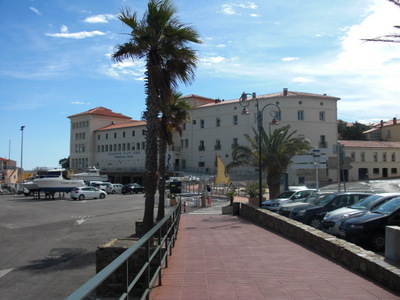
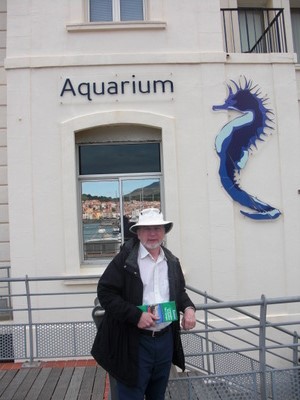 Having already visited Collioure, we could simply by-pass the turn toward it and devote the whole day to Banyuls, the southernmost Mediterranean resort town north of the Spanish border. It has several claims to fame—it's the site of a museum of the life and work of Aristide Maillol, several of whose works have already graced these pages; it's the site of the Laboratoire Arago, a well-known oceanographic institution (David used to have colleagues there, but they've all either retired or moved to other institutions, so he did not introduce himself professionally); and it produces a distinctive sweet wine that carries its name, which David loves with cold foie gras.
Having already visited Collioure, we could simply by-pass the turn toward it and devote the whole day to Banyuls, the southernmost Mediterranean resort town north of the Spanish border. It has several claims to fame—it's the site of a museum of the life and work of Aristide Maillol, several of whose works have already graced these pages; it's the site of the Laboratoire Arago, a well-known oceanographic institution (David used to have colleagues there, but they've all either retired or moved to other institutions, so he did not introduce himself professionally); and it produces a distinctive sweet wine that carries its name, which David loves with cold foie gras.
Collioure had been so busy with tourists, and its parking lots so full, that I can't imagine what it's like in July and August! Banyuls, on the other hand, was much calmer. We drove through it once to reconnoiter, then turned around and on the second pass found a convenient parking space right next to the boardwalk along the edge of the harbor. It had "horodateurs" every few spaces, which said parking was paid every day of the week, but they took only coins, and we didn't have enough. We therefore stopped into the outdoor terrace of quite a nice restaurant, a few steps away on the boardwalk. David had a decaf and I had a mineral water, and when the waitress brought our change, it still didn't include enought change, so David asked for some, for the parking. Don't bother, we were told. They don't enforce it until June 1!
So we strolled up the boardwalk to the Lab Arago to visit its aquarium, which is small but definitely worth a visit. At the left is a long view, showing the entire building, and at the right a closer one that shows its trademark seahorse logo.
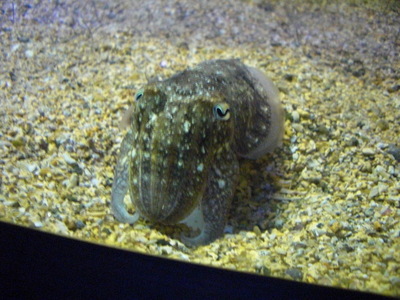
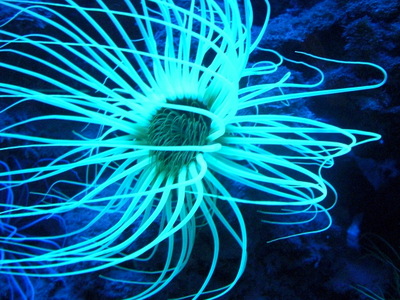 Inside, it's very compact, and you can get right up close and personal with the sea life in the tanks. This cuttlefish, a little smaller than my hand, sat and watched us the whole time, maintaining its sand camouflage and refusing to put on the amazing light show that some specimens do in response to movement or a touch on the glass.
Inside, it's very compact, and you can get right up close and personal with the sea life in the tanks. This cuttlefish, a little smaller than my hand, sat and watched us the whole time, maintaining its sand camouflage and refusing to put on the amazing light show that some specimens do in response to movement or a touch on the glass.
The anemone, however, positively glowed. I suspect they gave it a little black light to help the effect along.
Not pictured is a tank full of quite large hermit crabs to which they had given no shells. One of them had found a tiny broken piece of shell, which is held desperately to its backside, but the others were entirely nude and clearly nervous about it. They must live in a constant state of panic, searching their empty tank for something to wear!
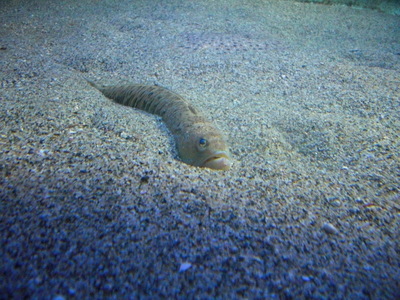
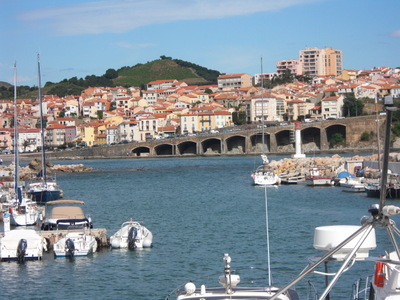 At the left here is a "vive" (a weever or scorpionfish; I didn't note which species). It lies on the bottom, mostly covered with sand (this one is more exposed than usual), waiting to ambush small prey that passes by. It also ambushes incautious wading humans who step on it; its venomous dorsal spines are very painful and even dangerous.
At the left here is a "vive" (a weever or scorpionfish; I didn't note which species). It lies on the bottom, mostly covered with sand (this one is more exposed than usual), waiting to ambush small prey that passes by. It also ambushes incautious wading humans who step on it; its venomous dorsal spines are very painful and even dangerous.
Sand-colored camouflage was very popular; we saw many tanks full of flatfish and rays of various species, all of which were authentically speckled to match their backgrounds. Of course we also saw larger fishes in larger tanks—groupers, loup de mer (bar), daurade, etc. I even got to see big-scale sand smelts on the hoof, as it were.
At the right is the view from the boardwalk back toward the road into town, which leads down this impressive stone ramp. As we could see in period photos at the lab, that descent was, within living memory, unsupported. I don't know whether they just finally got around to reinforcing it or whether a storm took the road out and necessitated the improvements. It's now as much a trademark of Banyuls as the lighthouse is of Collioure.
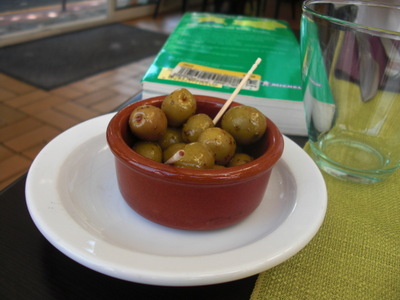
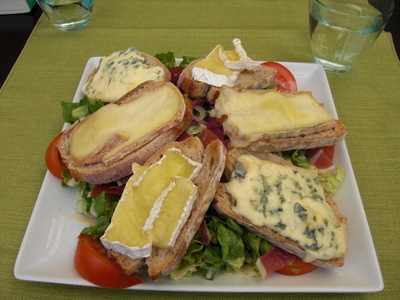 For lunch, we walked back along the boardwalk and stopped at L'Escale (the port of call), where they provided us with the little pot of particuarly good marinated olives while we studied the menu.
For lunch, we walked back along the boardwalk and stopped at L'Escale (the port of call), where they provided us with the little pot of particuarly good marinated olives while we studied the menu.
In the end, we both ordered "La grand gratinée," consisting of salad (with very good vinaigrette), raw ham ribbons, and toasts topped with grilled Camembert, Saint-Nectaire, and Bleu d'Auvergne. Great! I almost finished mine, but there was probably 3/4 lb of cheese on there, plus all that ham . . . I was also intrigued by the ready-assorted plates of tapas on offer, but that really would have been too much food.
We then strolled around the town for a while, waiting for the Office de Tourisme to reopen at 2:00 p.m. and the little white train, scheduled to depart at 2:30 p.m. When the office opened, though, they revealed that the train only ran starting 1 June. (So our discount ticket stubs from Collioure did no good.) But they did give us a a map on which they marked the Musée Maillol and the Terres des Templiers.
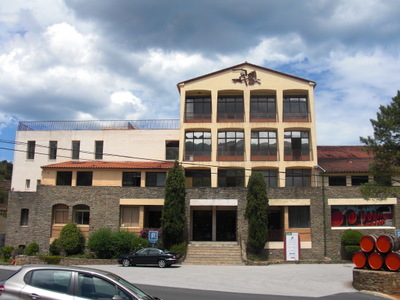
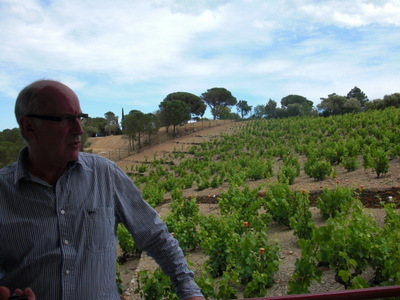 After retrieving the car, we headed up a side road toward the Terres des Templiers (Land of the Knights Templar), a large wine cooperative that produces a large assortment of wines of the Banyuls and Collioure appellations (and one Rancio and one absolutely delicious Banyuls vinegar), at least half of which are in their "off market" category—that is, they're never available commercially because the entire production is reserved and bought up privately or else sold only out the winery door.
After retrieving the car, we headed up a side road toward the Terres des Templiers (Land of the Knights Templar), a large wine cooperative that produces a large assortment of wines of the Banyuls and Collioure appellations (and one Rancio and one absolutely delicious Banyuls vinegar), at least half of which are in their "off market" category—that is, they're never available commercially because the entire production is reserved and bought up privately or else sold only out the winery door.
Here, our guide shows us a hillside of vines (from a balcony on the side of the building). He emphasized that the terrain is so steep that all the work of the vineyard is done by hand, starting at the beginning of the season with carrying the dirt (well, mostly rocks) back up the hills from the resting places below where the winter's storms and torrential rains have carried it. In a few places, mules are still used, but no machinery is used at all. Fortunately, he pointed out, the climate is so inhospitable that the fungal diseases that threaten vineyards in, e.g., Bordeaux and Burgundy, can't hack it; the vines are treated only once or occasionally twice a year. He said some of the vines are over a hundred years old, but he ducked my question about Phylloxera, so I don't know whether it was a problem here.
Notice that the vines are planted "en foule," that is, not in rows or on trellises. Each is freestanding.
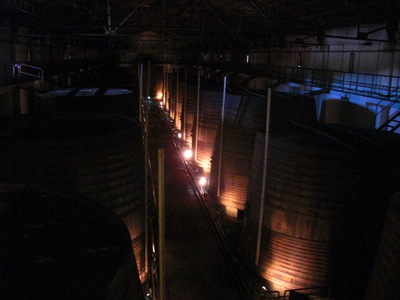
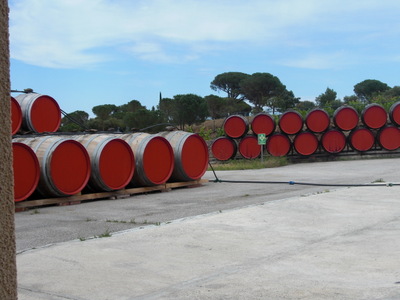 The tour spent a lot of time on the aging processes of the different wines and almost none on harvest, crush, fermentation, or bottling, because all of these excep[t thje bottling are carried out at the individual wineries that make up the cooperative. The wines are them brought to Templiers for aging, blending, etc. The guide emphasized over and over that the company's Banyuls-aging barrels are huge, over 100 years old, and irreplaceable. At the left is a photo of the rather dimly lit larger of the winery's two indoor aging areas; each of those barrels is probably 10 feet high. For this area's wines, the older the barrels the better, unlike those of Burgundy, where the barrels are discarded after three years' use.
The tour spent a lot of time on the aging processes of the different wines and almost none on harvest, crush, fermentation, or bottling, because all of these excep[t thje bottling are carried out at the individual wineries that make up the cooperative. The wines are them brought to Templiers for aging, blending, etc. The guide emphasized over and over that the company's Banyuls-aging barrels are huge, over 100 years old, and irreplaceable. At the left is a photo of the rather dimly lit larger of the winery's two indoor aging areas; each of those barrels is probably 10 feet high. For this area's wines, the older the barrels the better, unlike those of Burgundy, where the barrels are discarded after three years' use.
At the right are the outdoor aging barrels, intended to simulate shipping of the wine by sea. The wines, depending on variety and intended result are aged either in the indoor barrels or the outdoor, not both, and not all even go through that stage. Some of the Collioures are aged more conventionally, in small new barrels. Both indoors and outdoors, the antique barrels must be sprayed periodically with water, to keep them water tight. Otherwise, the wood would shrink and open cracks through which the wine would leak out, and outdoors, unless barrels are kept wet, the wine escapes by evaporation right through the wood.
At the end of the tour, David got to taste seven of their wines, several of which were in the "off market" caegories. The French folks were whipping out their credit cards left and right, but unless we wanted to pay exorbitant prices to have bottles shipped, it wasn't practical for us to buy any.
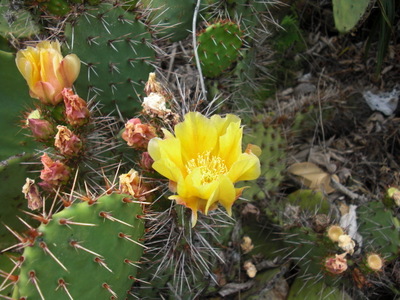
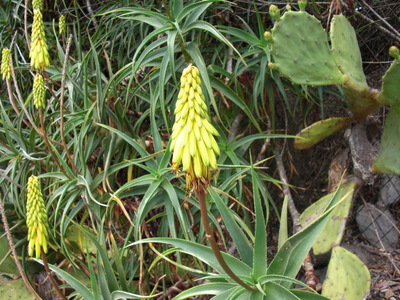 From the winery we backtracked to the turn toward the Maillol museum, which we had spotted on the way up. Signs led us through an ever more rustic series of roads to a parking lot in the woods and an arrow pointing on beyond to the museum. After a short climb up the small paved road, we came to a fork at which one arrow just pointed on along the road and said only "Musée Maillol" and the other pointed to a footpath and said "Musée Maillol, " 3/10 of a kilometer by the Liberty Path (the Liberty Path is a walking trail leading all the way from occupied France through Vichy France to Spain, along which people traveled secretly to get out of France so that they could join the free French forces). We continued to follow the paved road, realizing as we went along that it was the wrong choice. We continued to climb, and then finally to descent sharply, and could hear, all the way, the voices of a party of French people who arrived at the fork at the same time and took the footpath. They were clearly walking on the flat in the shade around the hill we were climbing over in the sun!
From the winery we backtracked to the turn toward the Maillol museum, which we had spotted on the way up. Signs led us through an ever more rustic series of roads to a parking lot in the woods and an arrow pointing on beyond to the museum. After a short climb up the small paved road, we came to a fork at which one arrow just pointed on along the road and said only "Musée Maillol" and the other pointed to a footpath and said "Musée Maillol, " 3/10 of a kilometer by the Liberty Path (the Liberty Path is a walking trail leading all the way from occupied France through Vichy France to Spain, along which people traveled secretly to get out of France so that they could join the free French forces). We continued to follow the paved road, realizing as we went along that it was the wrong choice. We continued to climb, and then finally to descent sharply, and could hear, all the way, the voices of a party of French people who arrived at the fork at the same time and took the footpath. They were clearly walking on the flat in the shade around the hill we were climbing over in the sun!
On the way, though, I got a couple of good flower photos: on the left a prickly pear and on the right a South African red-hot-poker kind of thing (probably Liliaceae), both (alas) exotics.
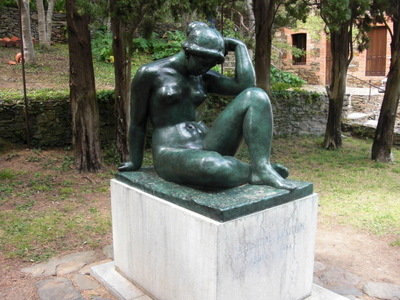
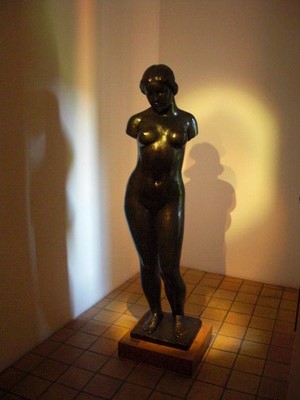 We got to the museum 20 minutes before it opened, so (along with the others who had shown up about the same time), we spent the time admiring the setting and the work on the left, which is displayed in the little flat grassy area before the front door. I think it's entitled "Mediterranean," but he produced quite a few similar, but subtly different, pieces, so I can't be sure, but if it is, it is said to have established Maillol as the first modern sculptor.
We got to the museum 20 minutes before it opened, so (along with the others who had shown up about the same time), we spent the time admiring the setting and the work on the left, which is displayed in the little flat grassy area before the front door. I think it's entitled "Mediterranean," but he produced quite a few similar, but subtly different, pieces, so I can't be sure, but if it is, it is said to have established Maillol as the first modern sculptor.
The museum displays a good deal of Maillol's work, especially the early and less characteristic stuff, but it concentrates on his biography and methods of working. He acquired the house that is now the museum later in life (it's not his birthplace, although he's from the Banyuls area), and he liked to retire there in summer to work; it's way back at the end of a tiny valley and reportedly gets pretty hot and dusty by July and August.
Inside was, among other things, "Harmony," this statue without arms. It was my favorite, and I learned later that it's considered the culmination of his work. The profile of the head is wonderful. I never thought he was very good at hair, but it turns out that Dina Vierny, his last model, actually wore her hair in a braid wrapped around her head, so maybe he wasn't too far off.
When he died, he left everything to Dina, who made a gift of it to the state and started a foundation that was quite successful in promoting him.
Besides all the photos, documents, sketches, and other works on display, we got to watch an hour-long film made during his lifetime (he died in 1944) about him, his lifestyle, and his artistic methods.
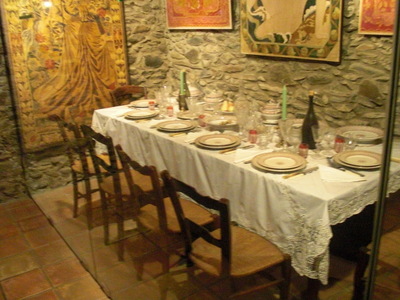
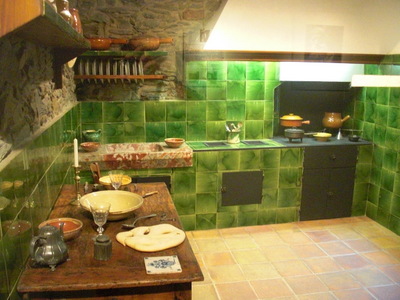 He liked to entertain guests at the house. When he was there alone, he lived very frugally, mostly gathering and cooking weeds the film seemed to say, but among guests he was famous for his cooking and his taste in wine.
He liked to entertain guests at the house. When he was there alone, he lived very frugally, mostly gathering and cooking weeds the film seemed to say, but among guests he was famous for his cooking and his taste in wine.
In the basement, together with the monitoring showing the film in continuous loop, were a table set as he used to set it for a guest dinner and his kitchen, pretty much as is left it. The pale, rather shapeless object just behind the blue tile in the foreground is a "fougasse," a typical southern French specialty bread, but I'm pretty sure it's not one he left there personally.
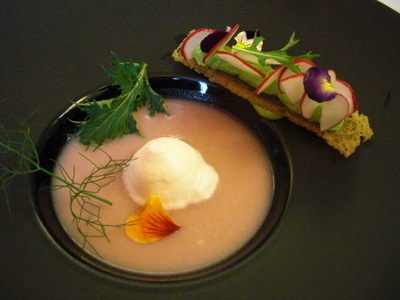
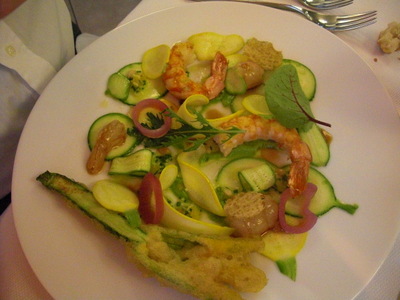 Back in Perpignan, we went back to La Galinette. Out of curiosity, I asked whether they had been open the previous night. Yes, they had! But as things went, we were pretty happy with the steak we got instead.
Back in Perpignan, we went back to La Galinette. Out of curiosity, I asked whether they had been open the previous night. Yes, they had! But as things went, we were pretty happy with the steak we got instead.
The first amuse-bouche was the same as three nights earlier, but the second had changed. Instead of soup of young fava beans, we got warm soup of pink radishes, and the little crispy crouton was spread with butter puréed with the radish tops and topped with a different assortment of veggie slices, mostly radishes. Our conclusion was that, the first time, the crouton was better than the soup but that this time, the reverse was true. Not that they weren't both delicious both times!
First course, David: "Carpaccio of gambas," i.e., large prawns, both cooked and raw, served with a different assortment of little zucchinis from the chef's garden, this time including an outstanding tempura treatment of a lengthwise half of a baby zucchini with its flower still attached.
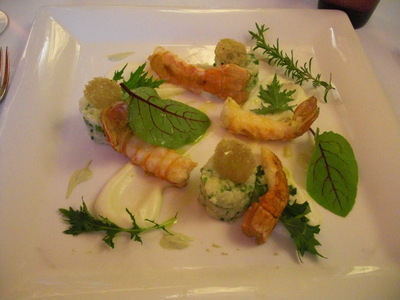
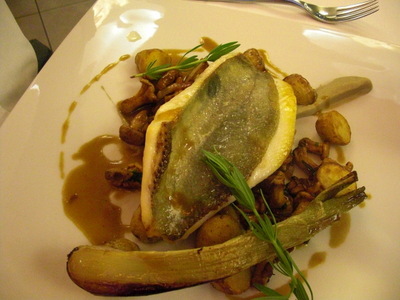 First course, me: roasted langoustine (Nephrops norvegicus tails with cauliflower two ways (comets of purée, timbales of finely chopped and cooked with herbs) and pale-green smears of mild but tasty wasabi cream. Very, very yummy. The red-veined leaves on top are "oseille sanguine," blood sorrel. Very lemony flavored, like regular sorrel, and extremely decorative.
First course, me: roasted langoustine (Nephrops norvegicus tails with cauliflower two ways (comets of purée, timbales of finely chopped and cooked with herbs) and pale-green smears of mild but tasty wasabi cream. Very, very yummy. The red-veined leaves on top are "oseille sanguine," blood sorrel. Very lemony flavored, like regular sorrel, and extremely decorative.
Main course, David: One of the night's specials—grilled filet of "St. Pierre" (Zeus faber) fish on a bed of sautéed chanterelle mushrooms and tiny "grenaille" potatoes. In the foreground, a roasted spring onion.
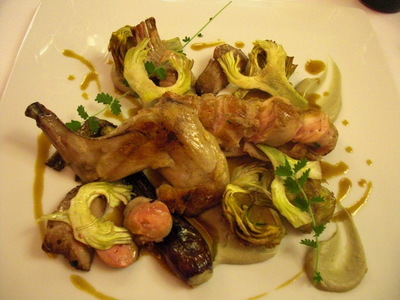
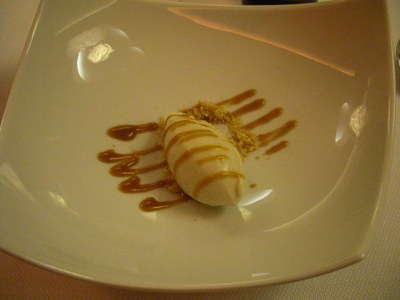 Main course, me: Described on the menu as "saddle of rabbit" but in fact, a whole half of a rabbit. The saddle was boned and rolled and roasted until pink inside and very tender. That's the round slices you see fanned along the 3 o'clock radius of the plat. At about 11 o'clock, you can see the ends of four tiny ribs sticking up. That's the rack of rabbit, grilled. Finally, in front, the shoulder quarter, marinated and "confit," until meltingly tender, like duck confit.
Main course, me: Described on the menu as "saddle of rabbit" but in fact, a whole half of a rabbit. The saddle was boned and rolled and roasted until pink inside and very tender. That's the round slices you see fanned along the 3 o'clock radius of the plat. At about 11 o'clock, you can see the ends of four tiny ribs sticking up. That's the rack of rabbit, grilled. Finally, in front, the shoulder quarter, marinated and "confit," until meltingly tender, like duck confit.
The long black object under it, topped near the front with a couple of roasted cherry tomato halves, is my roasted spring onion. Nestled here and there are the rabbits grilled liver and kidney. Finally, under it all are comets of artichoke purée, and sprinkled over the top are roasted artichoke hearts and thin slices of raw artichoke. The two green sprigs are salad burnet, called "pimprenelle" in French. I'd say this is my candidate for best main course of the trip.
Predessert: A quenelle of banana sorbet drizzled with salted caramel sauce.
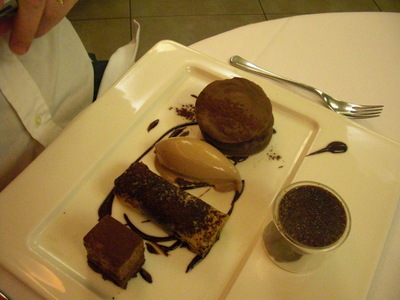
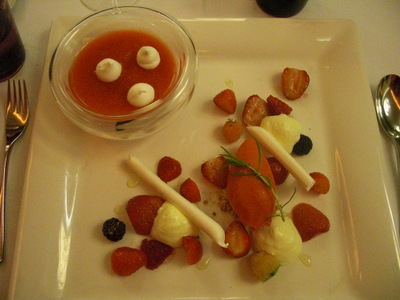 Dessert David: Variations on Ocoa chocolate—a creème brulée, a "pastilla" (second in line from the lower left; intense chocolate wrapped in a feuille de brike and baked until crisp), and ice cream. The other items, not mentioned specifically on the menu seemed to be a littl chocolate cake and a square of chocolate ganache. David raved about the whole thing.
Dessert David: Variations on Ocoa chocolate—a creème brulée, a "pastilla" (second in line from the lower left; intense chocolate wrapped in a feuille de brike and baked until crisp), and ice cream. The other items, not mentioned specifically on the menu seemed to be a littl chocolate cake and a square of chocolate ganache. David raved about the whole thing.
Dessert, me: Cold strawberry-honey-orange soup, strawberry sorbet, roasted and fresh strawberries, batons of crisp meringue, whipped cream, and red, black, and yellow raspberries! Delicious.
Throughout the meal, other tables, as the arrived, ordered the house cocktail, which was bright pink and arrived in small pilsner-style glasses, only half full. At the table, the waiter whipped out a whipped-cream dispenser and spritzed each glass full of matching bright-pink foam. We never did get around to asking what the heck the stuff was.
previous entry
List of Entries
next entry

 Having already visited Collioure, we could simply by-pass the turn toward it and devote the whole day to Banyuls, the southernmost Mediterranean resort town north of the Spanish border. It has several claims to fame—it's the site of a museum of the life and work of Aristide Maillol, several of whose works have already graced these pages; it's the site of the Laboratoire Arago, a well-known oceanographic institution (David used to have colleagues there, but they've all either retired or moved to other institutions, so he did not introduce himself professionally); and it produces a distinctive sweet wine that carries its name, which David loves with cold foie gras.
Having already visited Collioure, we could simply by-pass the turn toward it and devote the whole day to Banyuls, the southernmost Mediterranean resort town north of the Spanish border. It has several claims to fame—it's the site of a museum of the life and work of Aristide Maillol, several of whose works have already graced these pages; it's the site of the Laboratoire Arago, a well-known oceanographic institution (David used to have colleagues there, but they've all either retired or moved to other institutions, so he did not introduce himself professionally); and it produces a distinctive sweet wine that carries its name, which David loves with cold foie gras.
 Inside, it's very compact, and you can get right up close and personal with the sea life in the tanks. This cuttlefish, a little smaller than my hand, sat and watched us the whole time, maintaining its sand camouflage and refusing to put on the amazing light show that some specimens do in response to movement or a touch on the glass.
Inside, it's very compact, and you can get right up close and personal with the sea life in the tanks. This cuttlefish, a little smaller than my hand, sat and watched us the whole time, maintaining its sand camouflage and refusing to put on the amazing light show that some specimens do in response to movement or a touch on the glass.
 At the left here is a "vive" (a weever or scorpionfish; I didn't note which species). It lies on the bottom, mostly covered with sand (this one is more exposed than usual), waiting to ambush small prey that passes by. It also ambushes incautious wading humans who step on it; its venomous dorsal spines are very painful and even dangerous.
At the left here is a "vive" (a weever or scorpionfish; I didn't note which species). It lies on the bottom, mostly covered with sand (this one is more exposed than usual), waiting to ambush small prey that passes by. It also ambushes incautious wading humans who step on it; its venomous dorsal spines are very painful and even dangerous.
 For lunch, we walked back along the boardwalk and stopped at L'Escale (the port of call), where they provided us with the little pot of particuarly good marinated olives while we studied the menu.
For lunch, we walked back along the boardwalk and stopped at L'Escale (the port of call), where they provided us with the little pot of particuarly good marinated olives while we studied the menu.
 After retrieving the car, we headed up a side road toward the Terres des Templiers (Land of the Knights Templar), a large wine cooperative that produces a large assortment of wines of the Banyuls and Collioure appellations (and one Rancio and one absolutely delicious Banyuls vinegar), at least half of which are in their "off market" category—that is, they're never available commercially because the entire production is reserved and bought up privately or else sold only out the winery door.
After retrieving the car, we headed up a side road toward the Terres des Templiers (Land of the Knights Templar), a large wine cooperative that produces a large assortment of wines of the Banyuls and Collioure appellations (and one Rancio and one absolutely delicious Banyuls vinegar), at least half of which are in their "off market" category—that is, they're never available commercially because the entire production is reserved and bought up privately or else sold only out the winery door.
 The tour spent a lot of time on the aging processes of the different wines and almost none on harvest, crush, fermentation, or bottling, because all of these excep[t thje bottling are carried out at the individual wineries that make up the cooperative. The wines are them brought to Templiers for aging, blending, etc. The guide emphasized over and over that the company's Banyuls-aging barrels are huge, over 100 years old, and irreplaceable. At the left is a photo of the rather dimly lit larger of the winery's two indoor aging areas; each of those barrels is probably 10 feet high. For this area's wines, the older the barrels the better, unlike those of Burgundy, where the barrels are discarded after three years' use.
The tour spent a lot of time on the aging processes of the different wines and almost none on harvest, crush, fermentation, or bottling, because all of these excep[t thje bottling are carried out at the individual wineries that make up the cooperative. The wines are them brought to Templiers for aging, blending, etc. The guide emphasized over and over that the company's Banyuls-aging barrels are huge, over 100 years old, and irreplaceable. At the left is a photo of the rather dimly lit larger of the winery's two indoor aging areas; each of those barrels is probably 10 feet high. For this area's wines, the older the barrels the better, unlike those of Burgundy, where the barrels are discarded after three years' use.
 From the winery we backtracked to the turn toward the Maillol museum, which we had spotted on the way up. Signs led us through an ever more rustic series of roads to a parking lot in the woods and an arrow pointing on beyond to the museum. After a short climb up the small paved road, we came to a fork at which one arrow just pointed on along the road and said only "Musée Maillol" and the other pointed to a footpath and said "Musée Maillol, " 3/10 of a kilometer by the Liberty Path (the Liberty Path is a walking trail leading all the way from occupied France through Vichy France to Spain, along which people traveled secretly to get out of France so that they could join the free French forces). We continued to follow the paved road, realizing as we went along that it was the wrong choice. We continued to climb, and then finally to descent sharply, and could hear, all the way, the voices of a party of French people who arrived at the fork at the same time and took the footpath. They were clearly walking on the flat in the shade around the hill we were climbing over in the sun!
From the winery we backtracked to the turn toward the Maillol museum, which we had spotted on the way up. Signs led us through an ever more rustic series of roads to a parking lot in the woods and an arrow pointing on beyond to the museum. After a short climb up the small paved road, we came to a fork at which one arrow just pointed on along the road and said only "Musée Maillol" and the other pointed to a footpath and said "Musée Maillol, " 3/10 of a kilometer by the Liberty Path (the Liberty Path is a walking trail leading all the way from occupied France through Vichy France to Spain, along which people traveled secretly to get out of France so that they could join the free French forces). We continued to follow the paved road, realizing as we went along that it was the wrong choice. We continued to climb, and then finally to descent sharply, and could hear, all the way, the voices of a party of French people who arrived at the fork at the same time and took the footpath. They were clearly walking on the flat in the shade around the hill we were climbing over in the sun!

 We got to the museum 20 minutes before it opened, so (along with the others who had shown up about the same time), we spent the time admiring the setting and the work on the left, which is displayed in the little flat grassy area before the front door. I think it's entitled "Mediterranean," but he produced quite a few similar, but subtly different, pieces, so I can't be sure, but if it is, it is said to have established Maillol as the first modern sculptor.
We got to the museum 20 minutes before it opened, so (along with the others who had shown up about the same time), we spent the time admiring the setting and the work on the left, which is displayed in the little flat grassy area before the front door. I think it's entitled "Mediterranean," but he produced quite a few similar, but subtly different, pieces, so I can't be sure, but if it is, it is said to have established Maillol as the first modern sculptor. 
 He liked to entertain guests at the house. When he was there alone, he lived very frugally, mostly gathering and cooking weeds the film seemed to say, but among guests he was famous for his cooking and his taste in wine.
He liked to entertain guests at the house. When he was there alone, he lived very frugally, mostly gathering and cooking weeds the film seemed to say, but among guests he was famous for his cooking and his taste in wine.
 Back in Perpignan, we went back to La Galinette. Out of curiosity, I asked whether they had been open the previous night. Yes, they had! But as things went, we were pretty happy with the steak we got instead.
Back in Perpignan, we went back to La Galinette. Out of curiosity, I asked whether they had been open the previous night. Yes, they had! But as things went, we were pretty happy with the steak we got instead.
 First course, me: roasted langoustine (Nephrops norvegicus tails with cauliflower two ways (comets of purée, timbales of finely chopped and cooked with herbs) and pale-green smears of mild but tasty wasabi cream. Very, very yummy. The red-veined leaves on top are "oseille sanguine," blood sorrel. Very lemony flavored, like regular sorrel, and extremely decorative.
First course, me: roasted langoustine (Nephrops norvegicus tails with cauliflower two ways (comets of purée, timbales of finely chopped and cooked with herbs) and pale-green smears of mild but tasty wasabi cream. Very, very yummy. The red-veined leaves on top are "oseille sanguine," blood sorrel. Very lemony flavored, like regular sorrel, and extremely decorative.
 Main course, me: Described on the menu as "saddle of rabbit" but in fact, a whole half of a rabbit. The saddle was boned and rolled and roasted until pink inside and very tender. That's the round slices you see fanned along the 3 o'clock radius of the plat. At about 11 o'clock, you can see the ends of four tiny ribs sticking up. That's the rack of rabbit, grilled. Finally, in front, the shoulder quarter, marinated and "confit," until meltingly tender, like duck confit.
Main course, me: Described on the menu as "saddle of rabbit" but in fact, a whole half of a rabbit. The saddle was boned and rolled and roasted until pink inside and very tender. That's the round slices you see fanned along the 3 o'clock radius of the plat. At about 11 o'clock, you can see the ends of four tiny ribs sticking up. That's the rack of rabbit, grilled. Finally, in front, the shoulder quarter, marinated and "confit," until meltingly tender, like duck confit. 
 Dessert David: Variations on Ocoa chocolate—a creème brulée, a "pastilla" (second in line from the lower left; intense chocolate wrapped in a feuille de brike and baked until crisp), and ice cream. The other items, not mentioned specifically on the menu seemed to be a littl chocolate cake and a square of chocolate ganache. David raved about the whole thing.
Dessert David: Variations on Ocoa chocolate—a creème brulée, a "pastilla" (second in line from the lower left; intense chocolate wrapped in a feuille de brike and baked until crisp), and ice cream. The other items, not mentioned specifically on the menu seemed to be a littl chocolate cake and a square of chocolate ganache. David raved about the whole thing.